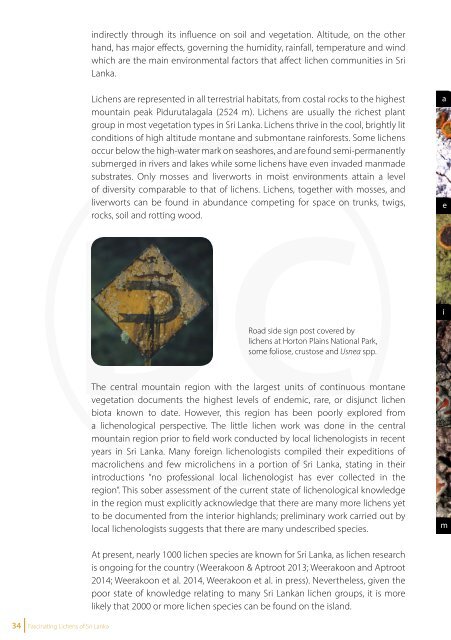Create successful ePaper yourself
Turn your PDF publications into a flip-book with our unique Google optimized e-Paper software.
indirectly through its influence on soil and vegetation. Altitude, on the other<br />
hand, has major effects, governing the humidity, rainfall, temperature and wind<br />
which are the main environmental factors that affect lichen communities in <strong>Sri</strong><br />
<strong>Lanka</strong>.<br />
<strong>Lichens</strong> are represented in all terrestrial habitats, from costal rocks to the highest<br />
mountain peak Pidurutalagala (2524 m). <strong>Lichens</strong> are usually the richest plant<br />
group in most vegetation types in <strong>Sri</strong> <strong>Lanka</strong>. <strong>Lichens</strong> thrive in the cool, brightly lit<br />
conditions <strong>of</strong> high altitude montane and submontane rainforests. Some lichens<br />
occur below the high-water mark on seashores, and are found semi-permanently<br />
submerged in rivers and lakes while some lichens have even invaded manmade<br />
substrates. Only mosses and liverworts in moist environments attain a level<br />
<strong>of</strong> diversity comparable to that <strong>of</strong> lichens. <strong>Lichens</strong>, together with mosses, and<br />
liverworts can be found in abundance competing for space on trunks, twigs,<br />
rocks, soil and rotting wood.<br />
a b c d<br />
e<br />
f<br />
g<br />
h<br />
i<br />
Different types <strong>of</strong><br />
Crustose lichens<br />
j<br />
Road side sign post covered by<br />
lichens at Horton Plains National Park,<br />
some foliose, crustose and Usnea spp.<br />
Crustose lichens; The most diverse type <strong>of</strong> lichens<br />
in <strong>Sri</strong> <strong>Lanka</strong>. Knowledge <strong>of</strong> crustose lichens is most<br />
incomplete in <strong>Sri</strong> <strong>Lanka</strong>.<br />
The central mountain region with the largest units <strong>of</strong> continuous montane<br />
vegetation documents the highest levels <strong>of</strong> endemic, rare, or disjunct lichen<br />
biota known to date. However, this region has been poorly explored from<br />
a lichenological perspective. The little lichen work was done in the central<br />
mountain region prior to field work conducted by local lichenologists in recent<br />
years in <strong>Sri</strong> <strong>Lanka</strong>. Many foreign lichenologists compiled their expeditions <strong>of</strong><br />
macrolichens and few microlichens in a portion <strong>of</strong> <strong>Sri</strong> <strong>Lanka</strong>, stating in their<br />
introductions “no pr<strong>of</strong>essional local lichenologist has ever collected in the<br />
region”. This sober assessment <strong>of</strong> the current state <strong>of</strong> lichenological knowledge<br />
in the region must explicitly acknowledge that there are many more lichens yet<br />
to be documented from the interior highlands; preliminary work carried out by<br />
local lichenologists suggests that there are many undescribed species.<br />
m<br />
k<br />
a. Haematomma accolens, b. Letrouitia parabola,<br />
c. Cratiria obscurior, d. Letrouitia subvulpina,<br />
e. Brigantiaea leucoxantha, f. Malmidea granifera,<br />
g. Haematomma africanum, h. Lecanora helva,<br />
i. Letrouitia domingensis, j. Lecanora leprosa,<br />
k. Haematomma flexuosum, l. Bacidia millegrana,<br />
m. Lecanora tropica, n. Megalospora sulphurata,<br />
o. Malmedia leproloma, p. Malmedia bakeri,<br />
q. Ramboldia russula, r. Cresponea proximata<br />
l<br />
n<br />
At present, nearly 1000 lichen species are known for <strong>Sri</strong> <strong>Lanka</strong>, as lichen research<br />
is ongoing for the country (Weerakoon & Aptroot 2013; Weerakoon and Aptroot<br />
2014; Weerakoon et al. 2014, Weerakoon et al. in press). Nevertheless, given the<br />
poor state <strong>of</strong> knowledge relating to many <strong>Sri</strong> <strong>Lanka</strong>n lichen groups, it is more<br />
likely that 2000 or more lichen species can be found on the island.<br />
34 <strong>Fascinating</strong> <strong>Lichens</strong> <strong>of</strong> <strong>Sri</strong> <strong>Lanka</strong><br />
o p q r















